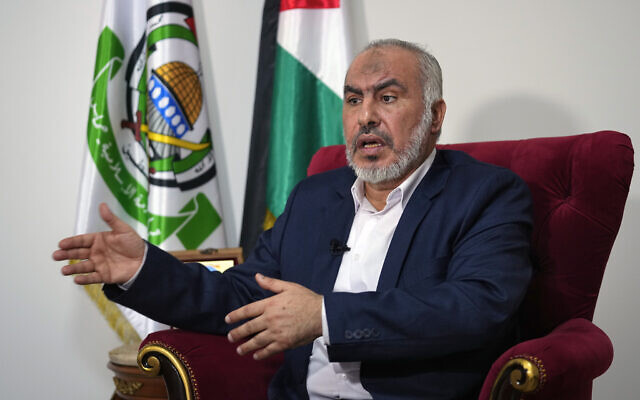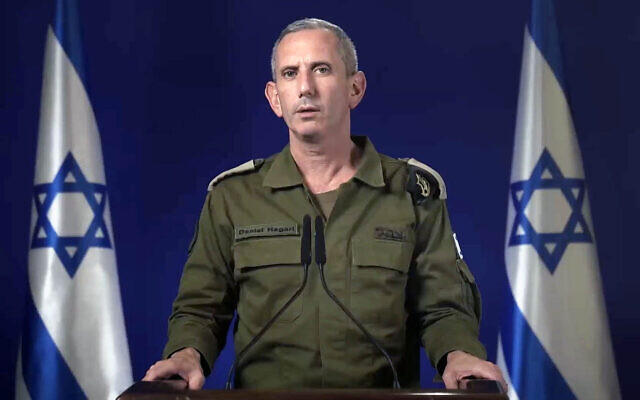Terrorize Israelis while eliciting sympathy abroad: Inside Hamas’s propaganda strategy
In accordance with its founding charter, Hamas uses a sophisticated media presence and uniform narrative to rally its base — and turn the world against Israel

On August 19, Hamas claimed responsibility for an explosion in Tel Aviv the day before, a suicide bombing carried out as a joint operation with the Palestinian Islamic Jihad. The terror group vowed to continue such attacks in the future.
The attack only failed because the bomb the terrorist was carrying in his backpack detonated before he reached his destination, killing him instantly and moderately wounding a passerby.
Following the claim, Hamas quickly disseminated posters on social media depicting images of blown-up buses in Tel Aviv. The captions, written in Arabic, Hebrew and English, boldly declared, “We are coming.”
The message was clear: Hamas was signaling the start of a new wave of suicide attacks reminiscent of the terror campaign that gripped Israel in the 1990s and peaked during the Second Intifada in the early 2000s.
The posters were carefully designed, featuring terrorists wearing Palestinian keffiyehs and explosive belts, standing beside buses like those that operated in Israel decades ago.
One poster prominently featured Yahya Ayyash, known as “the Engineer,” the mastermind behind a series of deadly bombings in the mid-1990s. Ayyash was killed by Israel in 1996. The Arabic caption underneath his image read: “Who will bring back the glory of Ayyash?”

According to experts, Hamas’s propaganda operation is a well-oiled machine, aiming on one front to instill fear among Israelis and on another to rally support from its Palestinian and international bases.
Guy Aviad, a former IDF history department official and author of “The Politics of Terror – An Essential Hamas Lexicon,” (2014), noted that the terror group views its media operations as “an additional battlefield, parallel to its physical war efforts.”
To achieve this, Hamas employs highly skilled media professionals, many of whom received their education in the West.
“Their output is technically of very high quality,” Aviad said. “This level of sophistication is also seen in Hezbollah’s media, such as their recent high-definition video showcasing their underground tunnel system. Jihadist groups often learn from each other.”

The roots of Hamas’s propaganda
From its early days in the late 1980s, during the First Intifada, Hamas recognized the power of public relations. Out of the 36 articles in its founding charter, two were explicitly dedicated to the importance of propaganda.
Article 29 emphasized the need to garner support across the Arab and Muslim world through “solidarity conferences, the issuing of explanatory bulletins, favorable articles and booklets, and enlightening the masses regarding the Palestinian issue.” Article 30 discussed the crucial role of “writers, intellectuals, media people, orators, educators and teachers” in countering the “Zionist influence” globally.
“The effective word, the good article, the useful book… all these are elements of jihad,” Article 30 of the Charter read.
Early on, Hamas also developed a sophisticated system of dawah in Gaza and the West Bank. The term, meaning “invitation [to Islam]” in Arabic, refers to an Islamist group’s civilian platform of social welfare — including schools, clinics and charities — through which it seeks to win over hearts and minds.
But the primary channel through which Hamas indoctrinates Palestinians is the mosque, where preachers embed its narratives within the sacred texts of Islam.

During the First Intifada, Hamas quickly realized the importance of foreign media coverage, and learned to time its communiqués strategically, often releasing statements just before evening news broadcasts in Israel or the United States, Aviad noted.
During those years, one of the most prominent figures in the terror group was Abdelaziz Rantisi, a co-founder and one of its first politburo leaders. When Israel deported him and 415 other Hamas members to southern Lebanon in 1992, Rantisi became the group’s spokesman.
“The deportation to Lebanon was one of the biggest mistakes Israel ever made, as it exposed Hamas to the international media,” Aviad said. “Hamas started making global headlines. They had enough savvy members, including Rantisi, who spoke good English, to present their narrative effectively.”

A diversified and technologically advanced media strategy
Hamas’s propaganda machine evolved alongside the technological revolution of the mid-1990s. The group quickly established a strong online presence across multiple platforms.
Michael Milshtein, head of the Palestinian Studies Forum at the Moshe Dayan Center at Tel Aviv University, provided The Times of Israel with a detailed overview of the numerous outlets run by the terror group, which publish news around the clock.
Next to the official Hamas website, Hamas.info, its most prominent news platform is Palinfo.com, which stands for the “Palestinian Information Center.” The site is available in multiple languages — English, Arabic, French, Russian, Turkish, Urdu, Farsi, and Malaysian — targeting a potential audience of hundreds of millions across the Muslim world.
Hamas also operates several Arabic-only news websites, including Felasteen.news, Shehabnews.com, Safa.ps, and Alresalah.ps. Many of these outlets are active on social media platforms like X and Telegram.
A poster disseminated by Hamas on Telegram reading ‘Death awaits the settlers in every corner’ and ‘#Strike_your_enemy’
Alresalah (“the message” in Arabic) and Felasteen (“Palestine”) were also printed newspapers circulating in the Gaza Strip before October 7.
Hamas is adept at tailoring its messaging to different audiences. Shehab, for example, focuses on younger generations with simpler messages, slogans and songs, while outlets like Felasteen and Alresalah are more sophisticated, offering in-depth articles, analyses and op-eds.
Before October 7, Hamas also operated the popular TV and radio station Al-Aqsa in Gaza, which was bombed during the recent conflict. For a long time, Al-Aqsa TV was the most popular Palestinian channel.
According to a March 2023 poll by the Palestinian Center for Policy Survey Research (PCPSR), it had a larger viewership than the Ramallah-based Palestine TV, controlled by Fatah, Hamas’s rival party (14% vs. 11%). The media strategy of Fatah pales in comparison, Milshtein noted.
Although the Hamas logo does not appear on these websites, Milshtein said that “there isn’t a single Palestinian who doesn’t know they are run by Hamas.” Some outlets, like Safa.ps, may not initially seem connected to the terror group, but their news coverage is unmistakably aligned with Hamas.
Al Jazeera: A mouthpiece for Hamas
Al Jazeera, the Qatari-owned news network, also plays a crucial role in Hamas’s media strategy. The channel has by far a larger viewership in the Palestinian territories than any local channel. March 2023 found its rating stood at 28%. Since then, it has skyrocketed to 82%, according to a poll by the PCPSR from June of this year.
The Qatari channel has a longstanding relationship with the terror group, often acting as a platform for its messages.
On October 7, it aired a speech by Hamas’s military spokesman Abu Obeida, a move that some commentators described as serving as a mouthpiece for the terror group. “Anyone looking for Hamas’s latest video or official statements can easily find them on Al Jazeera,” Aviad said.

Other media resources, such as biographies of its “martyred” operatives, videos of training sessions and of recent attacks, and archives of past operations, can easily be found on Hamas’s official website and on that of its military wing, the Al-Qassam Brigades.
“Hamas places significant importance on historical memory,” Aviad said.
A unified message across multiple spokesmen
Hamas boasts a long list of spokesmen, stationed in Qatar, Lebanon, Turkey and elsewhere, many of whom also serve as politburo members.
Despite their numbers, the group’s message remains consistent. The political bureau sets the communication strategy, which is then uniformly conveyed by its spokesmen.
“It’s a highly sophisticated system,” Milshtein said. “They all deliver the same message, with a high degree of coordination and no daylight between them. Consensus is one of the core pillars of Hamas. Politburo members may argue behind closed doors, but when they reach a decision, everyone is bound by it. There’s no room for personal opinions.”

“This is in stark contrast to Israel, where leaders might present conflicting messages. It is not rare to hear [Defense Minister Yoav] Gallant say one thing, and [Prime Minister Benjamin] Netanyahu say something different. In Hamas, such discrepancies are almost nonexistent,” said Milshtein.
Aviad concurred, noting that Hamas has been more effective in its media strategy than Israel during this war. “Hamas is much more advanced. They know how to use international platforms — not just Al Jazeera.”
“In Israel, official communications come mainly from the army spokesman, but the government largely neglects public advocacy efforts,” Aviad said.
In the early months of the war, Hamas politburo members Osama Hamdan and Ghazi Hamad held weekly press conferences from Beirut to update the international press on Gaza’s situation and truce negotiations with Israel.
Additionally, dozens of freelance journalists — not always necessarily affiliated with Hamas — report daily from Gaza, recording and broadcasting scenes of death and destruction without filters.
“In Israel, most of these scenes are not shown, but the rest of the world sees them, and they make an impact,” Aviad said. “Meanwhile, Israelis are watching prime-time reality shows, as if we’re living in a parallel universe.”



1 comment:
Whoever does art work for Hamas is very good,.
Post a Comment